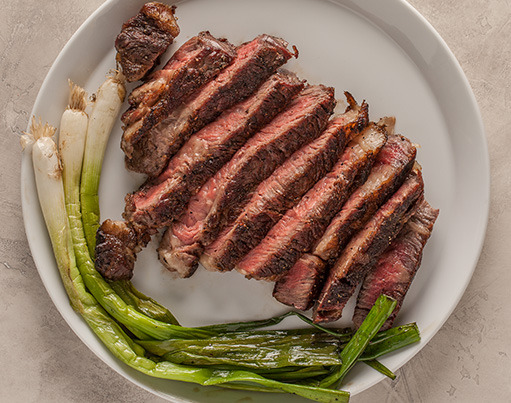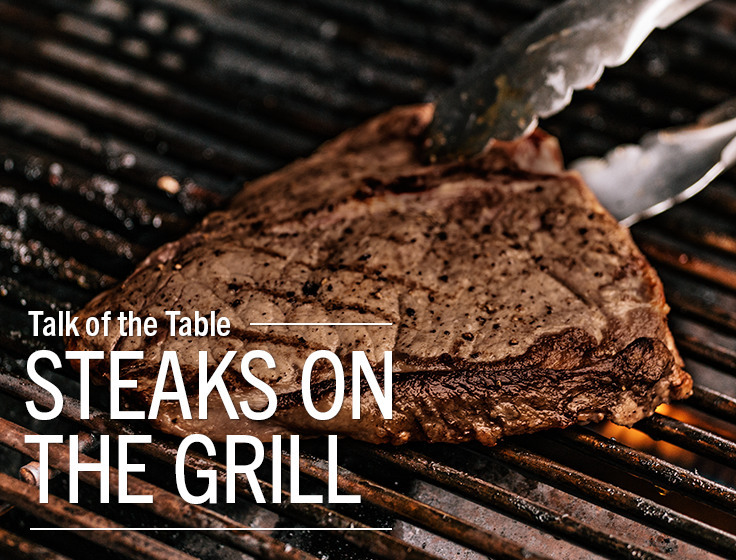Cut for the right occasion – grilling steaks
Michael Selby, our executive chef, compares different cuts of steak and how to grill them. Plus, check out a simple video on how to perfectly grill boneless rib-eye, one of our most popular cuts of steak!
The time to grill a juicy steak is now. Beef you say? The journey always begins at a Lunds or Byerly’s meat counter and then it happens. Which cut should I get? What if I overcook it? What if I undercook it? Will it dry out if my guests are late? And so it begins, as you examine your level of apprehension a little voice in the back your mind is saying “let’s just grill chicken, it’s easy and everyone loves it.”
Please tell that little voice that 70% of the battle is simply selecting the right cut for the occasion. Being mindful of your elements and equipment as well as the overall mood and theme of your event is really all you need to do to become a steak hero. Tonight!

Let’s review some of the more popular steaks as well as a few examples of exciting things that can happen:
Tenderloin: Believe it or not, a large portion of the beef-eating universe think a steak with very little fat and no bone is a good thing. Have you ever watched someone nervously try to cut and trim around something at the table with a dull knife all while trying to answer a serious question? Have you ever heard the expression “you could cut the tension in the room with a knife”? When cooked properly, even the dullest of knives will slice right through, making it easy to share. This steak is the absolute first choice for dinner with clients, clubs, banquets, holiday parties, first dates, and any potentially awkward situation that has even the slightest chance of taking place anywhere near a dinner table.
What you need to know: Keep a thermometer close and your head in the game, as this steak is very easy to overcook. Have a plan for sides! This sweet little symmetrical centerpiece sits right in the middle of your plate leaving lots of room for presentation and garnish. When the setting is strictly civilized, stick with the tenderloin.
Rib-eye: Nearly all of the rib-eye’s qualities can be attributed to excellent marbling and higher fat content. Steaks with such attributes have a much stronger flavor and absorb marinades far better than leaner cuts.
What you should know: When grilling rib-eye steaks, it’s often a balancing act with grill temperatures, especially when using charcoal. On a lower temperature setting you run the risk of approaching medium rare before all of the fat is rendered which can cause the steak to become less tender. On a higher temperature setting you run the risk of flames and flare-ups (especially when marinated), which can cause the steak to become extremely bitter. It’s best to stick with a gas grill that you are extremely familiar with and also to have a small glass of water close by to extinguish any flare-ups that may happen. When cooked properly, the rib-eye can be one of the most flavorful steaks on the market.
New York Strip: I often refer to a New York strip steak as the “crowd pleaser.” Moderate marbling and shape make it extremely easy to cook on just about any grill at any temperature. It slices very easily and presents beautifully on top of salads or alongside other protein options. I often plan on fish for dinner and still walk out of the store purchasing one these to slice thin and serve alongside fish.
What you should know: What if I have leftovers? From steak omelets for breakfast to roast beef sandwiches for lunch, options are endless so don’t let the size or price discourage you. All in all, the New York strip is the most versatile and user-friendly steak there is. Charcoal grilling in the rain? Bring it on!
Porterhouse: OK, if you are anything like me, you’ll find yourself saying, “I want it all.” It must have a bone heaping with flavor, deep and rich marbling, and a tender bite. Oh, and by the way, I’m really hungry so it has to be huge. Look no further than a Porterhouse. The Porterhouse steak is comprised of two cuts, the strip and filet. Taken form the short loin, the porterhouse is typically the last 3 cuts of the loin where the filet is much larger. The remaining steaks are referred to as T-bones. I have discovered that there are two breeds of Porterhouse fans in this world, the “savvy” and the “scrappy.” Armed with a razor sharp steak knife and years of experience, a savvy steak connoisseur can easily navigate through a Porterhouse like a brain surgeon. The scrappy begin in similar fashion but with noticeably less precision; then at approximately 70% through, a “ding“ sound is heard. That’s the sound of a knife and fork being dropped in order to finish things off with both hands like a piece of fried chicken. This is another key example of knowing your guests and the importance of having sharp steak knives at the table.
What you should know: Being that the Porterhouse is comprised of two cuts it’s important to know that the most common mistake is to overcook the filet side. The best thing to do is identify an area of your grill surface where high heat is directly next to low heat. Often times it’s the old and neglected backyard grills that are best suited for cooking Porterhouse steaks because of their uneven surface temperature. The key is to place the steak on the grill in such a fashion that the strip is on high heat and the filet is on lower heat. Another technique I often use is to place the entire steak over medium heat. Once the filet side is seared, place 3 raw potato slices underneath the filet so it’s elevated approximately 2 inches off the grill leaving the strip side on the grill surface.
Now go forth and grill without fear. You will be a steak hero!
See also our guide to beef cuts >
Watch the video below from our Executive Chef Michael Selby on WCCO Saturday Morning for tips on cooking steak and how to utilize the reverse sear technique:






